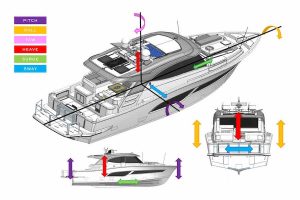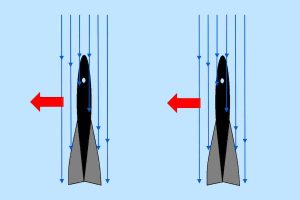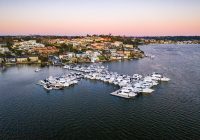The wizardry of the spinning gyro versus the play of the fin paddle. We take an in-depth look into the stabiliser universe to see which is better for your boating, or can they coexist?

Sea forces acting on our yachts’ hulls create the six vessel movements or degrees of freedom: pitch, roll, yaw, heave, surge and sway.
Steady as she goes, or staying stable.
Stabiliser technology has come a long way since the agricultural outrigger or “flopper stopper” days of the prawn trawlers, which featured long boom arms on both sides of the vessel with a heavy fish or triangle plates on the end of chains.
Think of the movie Perfect Storm where George Clooney had to shimmy out on the boom to cut one off so it didn’t destroy his trawler. These basic stabilisers work on the resistance of the plate hauling through the water as the vessel rolls, and dampens the rolling effect.
These days we have two main types of stabilisers designed to reduce effects of the sea on the stability of your motor yacht, both while at anchor and underway.
Experience magazine breaks down the differences between the two systems which fundamentally do the same job, or do they? And how do the mechanics perform and work? And what are their respective pluses and minuses?
How stabilisation works
A boat has six degrees of freedom – these are the different directions it can move in and, while they may all contribute to motion sickness, roll is the most significant, followed by yaw (vertical rotation) and sway (side-to-side motion).
Both gyros and fins work by exerting force against the motion of a boat.

The gyro stabiliser works by spinning the flywheel which endeavours to remain horizontal.



The gyro stabiliser takes about half an hour to spin up to full operating speed and about the same to wind down. A gyro works as if someone is holding onto the boat, reducing rolling left to right or pitching.
Fortunately, we don’t have to travel very far to find three experts in their fields at the Riviera factory. We firstly talked to Riviera technical writer Rob Partridge. Rob writes the owners’ manuals for our motor yachts and truly knows the technical side of Riviera motor yachts.
Asked to explain both systems in layman’s terms Rob says: “The gyro is basically a large heavy metal wheel sealed in a vacuum environment that spins extremely fast. The reason it is sealed in a vacuum is to take out air resistance, which makes it spin faster.
“The gyro stabiliser works by spinning the flywheel which endeavours to remain horizontal. It is on a gimble and always aiming to be level with the horizon forward and aft, and athwartships directions. If you can imagine a spinning top which, when spun, always tries to achieve the upright position.
“It takes about half an hour to spin up to full operating speed and about the same to wind down. A gyro works like someone is holding onto the boat, stopping it moving left to right or forward and backwards.”
According to Seakeeper, who makes the stabilisers, the flywheel can reach speeds of 557 miles per hour or just south of 900 kilometres per hour, depending on the model of the unit, which is dictated by the size of the vessel.
Rob says the argument for fins versus gyros has several considerations including the space that is required and the weight of the gyro, which comes in at around a tonne for a 60-foot motor yacht.
“The fins also rotate 360 degrees and will adjust left and right to counteract the roll and pitch of the vessel. The system detects a motion in one direction and paddles in the opposite direction to make the boat stay level, like duck feet paddling away below the surface.
“But it is worth noting only the stabiliser fins, not the gyros, work in conjunction with the trim tabs to keep the vessel’s ride level when underway.”
Continuing our research into the secrets of stabilisers, we spoke with Riviera’s Final Quality Control & Sea Trials Manager Dean Brickell.
Dean is the final stage in quality control at Riviera – he and his team test and trial our yachts on water to ensure the best quality control. He makes sure everything works before the yachts are handed over to the Riviera dealer and delivered to the owner. Dean has been instrumental in the sea trial development of both the gyro and fin systems on Riviera motor yachts and has practical working experience of the stabiliser systems both in local waters and while on extended ocean voyage passage making.
At anchor
“Gyro stabilisers are good for an at-rest scenario, perfect for stabilising a motor yacht at anchor, with no moving parts on the external hull. The cost is reasonably similar, but the benefit of the fins at anchor is that they are run off the ship’s power and you don’t need a generator running like you do with a gyro system.
“And when you do consider that you need a generator running to power the gyro, you must consider the noise aspect both for you and your neighbours. Of course, the fins aren’t totally silent, they are moving around below the yacht keeping strain on your anchor, but if you do weigh up both systems in terms of noise, the fins are substantially quieter. The fin negatives include, while at anchor, the issue of people swimming around the yacht. So it is always advisable to deactivate the fins if you have people in the water to avoid any wash or possible contact.”
Weight
“And then of course there is the weight of a gyro versus the fin system, the former being a tonne plus. With the latter 250 kilograms per servo motor – there is one servo motor which drives each fin per side – that is half the weight at 500 kilograms plus the extremely light carbon fibre fins. This also means less fuel consumption.”
Cruising
“If you are travelling at less than 10 knots the gyro works better, whereas the fins are effective at zero-speed mode which gives you stabilisation at anchor and at all boat speeds above 10 knots.”
Is two better than one?
“We do have instances of yachts being fitted with both types of stabilisers, more for remote clients who require redundancy. However, you wouldn’t want to have them operating at the same time as that would be counter-intuitive and they would work against each other. If both systems are installed it is better to use them separately. For instance, the gyro at anchor and under 10 knots, and the fins for passage making. But the cost and extra weight of having both installations onboard strengthens the argument to choose one system over the other.”

Automatic trim control always delivers perfect running trim by controlling the pitch the vessel has while underway.

The greater the speed the more water flow there is, and the more force is created to counter motion. Because their potential force increases with speed, fins are well suited to faster ocean-going motor yachts.

Natural integration between the trim tabs and the Humphree fins gains active ride control, coordinated turning, auto list and auto trim through the Interceptor system.

The carbon fibre fins are easily installed on the bottom of the servos and precisely torqued up to the manufacturer’s specifications.
Dan Henderson, Riviera’s Design and Engineering Director, lends his experience to this topic.
“We have had some very good reports from people using fins on long trips in New Zealand. You do have to consider that the gyro adds a fair bit of extra weight to the boat, and they are usually positioned right at the back of the yacht so they can change the trim slightly. While the fins don’t add anywhere near as much mass to the boat, you do have the additional draught caused by the fins.”
Performance
“In terms of performance detraction on a yacht they are about equal. The fins cause a very small amount of drag while the mass of the gyro also slows down the yacht slightly.
“If you look back 10 years ago, we were fitting an occasional gyro and now more than 50 per cent of the yachts have them. But in the past two years the trend has gone towards fins which have been well accepted. And a lot of that is to do with the fact they are Humphree fins, which are electric and they integrate to the Humphree trim tab (Interceptor system).
“So, you get excellent active ride control, coordinated turning, auto list and auto trim, making a good complete system. This brings me to talking about using the two systems together, and we recommend you don’t use them at the same time, just independent of each other.”
Summary
Ultimately it is up to the individual yacht owner to make the decision. However the two systems are different, and the points below should be considered when making the choice between the two. You should also consider how and where you like to use your motor yacht.
Take into account:
- The fuel economy and upfront expense of both items are comparable;
- The draft of the fins versus no extra appendages on the outside of the hull to risk entanglement, makes the gyro better for shallow cruising;
- Performance over 10 knots is better with the fins;
- Performance under 10 knots and while at anchor is better with the gyro;
- Natural integration between the trim tabs and the fins gains better ride control for the fins through the Interceptor system and an integration doesn’t exist for the gyro;
- For power you need to use your generator to run a gyro where the fins use the ship’s power, so noise becomes a consideration.







